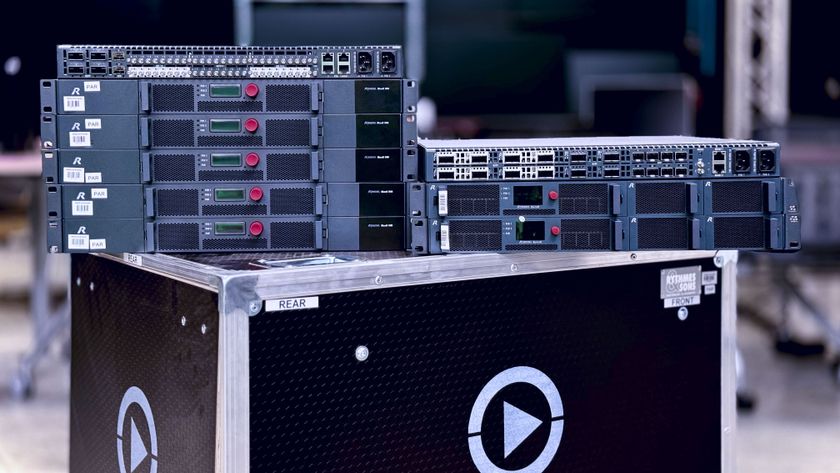There's something unmistakable about the resonant swish of a figure skater's blade on ice, a subtle scraping sound that when properly captured is like none other in sports. That swish now can be more clearly heard through a new Atlas Sound audio system at the St. Margaret's Centre in Halifax, Canada.
When the St. Margaret's Bay Association in the Halifax Regional Municipality, Nova Scotia, undertook a recent $10 million (Canadian) renovation for its community complex, the association turned to Navigator Technologies in Halifax to design and install AV, IT, paging and security systems.
The complex, about 100,000 square feet, is home to the Bay Ducks Junior B Hockey Team and is used for all amateur levels of ice hockey. It hosts Skate Canada figure-skating competitions as well as community events, and contains both NHL-sized and Olympic-sized ice rinks, a gym and administrative offices.
Renovated with concrete, steel and corrugated aluminum, the project presented Navigator with challenges around its many reflective surfaces such as glass walls and the ice itself, said Navigator president, Ray Courtney. "This is the first ice surface we've done," he noted, "and it was imperative that the system yield quality sound with minimal reverberation and that it address the two sound fields-ice surface and stadium seating."
Courtney added, "We didn't know about the corrugated aluminum interior of the building at the start of the project, and we had to change the angles of the speakers accordingly to minimize reflection."
Navigator, a 4-year old company formed by a group of experienced technology consultants in the Atlantic Canada region, designed and installed identical ice rink systems: Atlas SM12CXT-B speakers in a center array firing at various angles around the ice surface, and Atlas AT100RM attenuators to ensure consistent sound levels at any area on the ice surface. The Bogen-powered system features M-450 amps and CAM8 mixers.
The Navigator team discussed the project with Atlas Sound technical support specialist, Steve Brooks, whose knowledge and design abilities were incredibly helpful, Courtney said. "Atlas provided the best support and no one else at the time could have provided what they did; other solutions were far out of the municipal budget. They're a tremendous company, and their quality is impeccable."
The rink systems feature linear arrays facing the bleachers, in line with rink sides. Speakers are backed with sound-absorbent material to minimize sound migration onto the ice surface and acoustic tiles behind, in front of, and on the ceiling, stop reflection. "Delay is well under 2 seconds," Courtney explained. "Given the municipal budget, it's quite tremendous. Most other rinks in Atlantic Canada have 4- to 6-second delays."
For figure skating, where reflection problems are caused by time delays when skaters cross from zone to zone, the system can throw 98 decibels at the end of the ice surface. "They wanted to be able to turn off the speakers firing at the bleachers during figure-skating competitions in which they operate in a quiet atmosphere," Courtney pointed out. "This cuts back on noise floating back onto the ice surface, so we set it up so they could turn the speakers off."
Announcing needs varied according to types of events, Courtney said. "In hockey, most announcing is done from a rink-level booth, with a second mic for going out onto the ice. Figure skating is broadcast from a sound room above the rink."
To accommodate, a sound room houses the main equipment stack, and a remote stack is located at the sportscaster's booth at ice. Each location has mixer, multiple mic inputs, computer input, auxiliary audio and mic inputs and multifunction CD and tape units.
For video monitoring and security, the Honeywell design encompasses the entire complex, interior and exterior, with 32 color cameras digitally recorded on a 32-channel DVR holding from five to 20 days of images. "Video surveillance can be accessed from anywhere on the network," Courtney noted, "and video displays may be accessed from any office computer in the building. Viewing monitors have been placed in several public areas as an awareness tool. They've managed to reduce the number of break-ins and mischief, previously a significant problem."
Paging throughout the complex was necessary to address public safety and improve productivity. "We had to consider that several independently operated sound systems would be running throughout the building at high volume levels," Courtney observed. "To address this and the ducking requirements, we chose a Bogen PCM2000 paging system and modular amplifiers. The end result provides for multi-zone, as well as emergency paging into all areas of the complex. All sound sources are interconnected, and the pages are intelligible in all areas."












